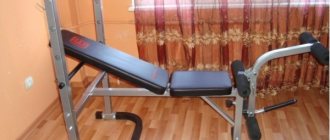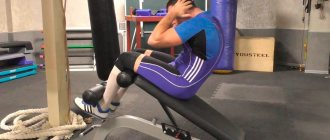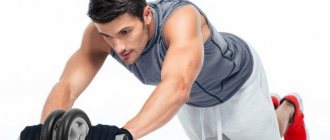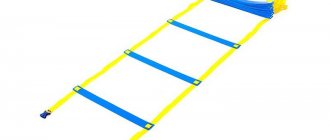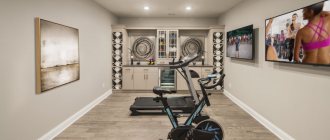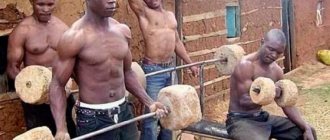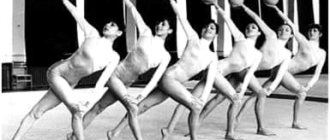Some athletes do hyperextension using their own weight from a lying position, that is, without any additional devices. There are also those who practice this exercise exclusively using a special bench. The latter option, as many believe, has a greater effect, but not everyone practices this approach. Even many of those who regularly visit the gym do not use a bench.
This situation is due to the fact that not all athletes know how to properly do hyperextension on this sports machine. This does not mean that you should continue to ignore this exercise, since it is the one that allows you to get the maximum benefit for your back training. It is enough to simply learn the technique of performing hyperextension, depending on which muscle group you want to focus on during training.
DIY home exercise equipment: pros and cons
As you can see, some exercise machines are quite easy to make with your own hands, while others are extremely problematic. And it’s not even a matter of the complexity of the manufacturing technology itself. And the fact is that it requires certain materials (which you will have to buy!), professional high-quality tools and a number of skills. Therefore, before you make a simulator at home yourself, think carefully, carefully weigh all the pros and cons - your own patience and time are expensive.
If difficulties do not frighten you, you can safely get down to business.
Horizontal bar in the doorway
Horizontal bars in doorways or wall openings are undoubtedly the best do-it-yourself exercise machines for desperate homebodies who, nevertheless, do not want to lose shape and are worried about the “well-being” of their back. In addition, they are perfect for training in bad weather.
Making a horizontal bar for your home is not at all difficult.
Necessary materials:
- three-quarter pipe (length = opening width + 40 millimeters);
- Bulgarian;
- yews;
- drill with a metal drill bit.
Manufacturing technology:
- cut one end of the pipe into four parts (“the recess” should not exceed 22 millimeters);
- cut two parallel petals;
- in the remaining two, drill holes with a diameter of 4 millimeters;
- bend them 90 degrees;
- repeat the entire above procedure for the second side;
- secure the horizontal bar in the doorway.
Assembling a treadmill
Some exercise machines are extremely difficult to make with your own hands, and a treadmill is one of them.
It would seem that theoretically there is nothing complicated, all you need is:
- create a frame in the form of small runners or legs, as well as support for the canvas;
- connect it with horizontally located shafts;
- pull an elastic, dense fabric onto the shafts;
- connect one of the shafts to the motor (for an electric treadmill).
But in practice, everything turns out to be not so rosy, because:
- Finding suitable material for canvas “at the dacha” or “in Vasya’s garage” is almost impossible. Only adequate industrial solutions;
- such a design will be very cumbersome;
- The engine system is extremely complex, and if handled improperly it can be life-threatening.
Therefore, before you make a simulator, think a thousand times - is the game worth the candle? It’s one thing to make a simple ab roller, and quite another to tinker with an unreliable design. Which, moreover, can entail such a heap of material and time costs that it will be cheaper to purchase an industrially produced product.
Creation of models for the prevention of back diseases
Health exercise equipment for the back is characterized by its simple design. For example, the Evminov simulator is a pine board equipped with fastenings and locking handles. The device should be secured so that you can change the angle of inclination - this will allow you to stretch your back muscles with any intensity.
The Sobolev multifunctional exercise machine allows you to stretch your chest, back and oblique abdominal muscles. It is a metal frame with soft bolsters that are attached to the leg clamps and support for the back (stomach). It’s not difficult to make, but to assemble the frame of the simulator, you need to use electric welding equipment.
If you have to work at a computer for a long time, it is worth designing a Tolstunov seat. The simulator consists of a wooden seat, one support point and a base that holds the entire structure. The exercise machine does not need to be fixed on a regular chair, and sitting on it improves blood circulation and trains the short muscles of the spine.
Razumovsky's simulator is more difficult to construct. It is also made of wood, but turning the rollers requires skill with a lathe.
However, the Akhmetov simulator is considered the most difficult to design and install. This biokinetic device consists of a durable frame to which movable hand and foot supports are attached, and the movement itself on the simulator resembles the running of a wild cat.
Before making this design yourself, you should learn more about the principle of its operation from sports medicine doctors.
Advantages and disadvantages
The advantages of making sports equipment yourself are obvious. It is possible to adjust the projectile to the dimensions of a specific room. Weights, barbells, dumbbells and benches can be made from scrap materials lying around the country house. If desired, more complex equipment can be manufactured. Even if the family spends the summer in the city, there are probably friends who have a dime a dozen of unnecessary shops and metal structures.
There is no need to spend cosmic sums on the purchase of equipment, and the cost of fastening materials or weights for the barbell will cost adequate money. Many amateur athletes claim that making exercise equipment at home is quite possible.
Beginning athletes see the downside of this idea in the time investment.
After all, you will have to tinker with it yourself. There are fears that while you are doing the exercise machine, all desire to exercise will disappear. You can compensate for this shortcoming by turning to friends or acquaintances for help.
Other homemade exercise equipment options
Homemade exercise machines are widely used in all sports. For example, in table tennis, players construct a return board to practice shots without an opponent. The device is a panel made of polystyrene and an attached yoga mat, attached to the table at a slight angle. The sounds of impacts are muffled by the rug.
Synthetic ice is sold for ice hockey, which is convenient for practicing passes, shots, snaps and dribbling. Ballerinas, gymnasts and dancers achieve beautiful feet and high insteps by putting their legs under the sofa - cheap and cheerful.
Football players practice dribbles using stable and unstable stands - low sticks attached to the cross either with nails or a rigid spring. Skiers and swimmers work the muscles of the shoulder girdle with firewood or an axe, with maximum effort occurring in the initial phase of the movement.
Affordable workouts are a reality. You just need to sincerely love your sport and find the opportunity to devote every free minute to it.
In the next video you will learn how to make a simulator yourself using the Bubnovsky method.
Choosing the right exercise machine
The first selection criterion is price. The difference between expensive and cheap exercise machines is the maximum compliance with human biomechanics. A team of engineers, special designers and trainers is working to create a good sports equipment. The result is a simulator that is not only effective, but also meets safety standards and takes into account all the nuances of natural body movements. This also means the complete absence of unnecessary additional stress on the joints and tendons.
Horizontal hyperextension machine
Another important selection parameter is the material. It is better to choose a strength trainer for home made of sheet steel. The service life of the simulator is affected by the strength of the connections and the quality of the main frame. Cheap models are dangerous because they become loose much faster.
For tall and heavy-set people, it is important to consider the maximum weight of the multistation user. The Adidas fitness station indicates a maximum user weight of 135 kg.
A necessary element of a sports station is cables. Inexpensive options suffer from insufficient cable strength, which leads to serious injuries. When purchasing, you should pay attention to the possibility of changing loads.
A drawing of hyperextension will help you do it yourself
A high-quality exercise machine will allow the user to easily change the weight, inclination and height of the seats.
The functionality of the device plays an important role, since a home exercise machine should allow you to perform exercises to develop different muscle groups.
How to make a barbell?
Homemade exercise equipment such as barbells will always be popular. With their help (in various positions) you can effectively work out many muscle groups. And since hardware from a good manufacturer costs a lot, you have to, as they say, “improvise.”
Do-it-yourself home exercise equipment is almost always quick and inexpensive. Especially if it's a barbell.
The design of the barbell is represented by a bar (cylindrical rod) on which a load (plates that change the weight of the device) is attached. The neck can be made from reinforcement or a metal pipe reinforced with cement mortar. As a “backup” option - wood, characterized by a high degree of strength. The diameter of the product should be comfortable to grasp with your hands: as a rule, it is from 2.5 to 4.5 centimeters.
The length of the bar is chosen arbitrarily, taking into account the place for classes and their nature. Optimally - from 180 to 200 centimeters.
What are pancakes made from?
Pancakes can be easily replaced with wheels, heavy flywheels, and brake discs. You can cast a weight from concrete. At worst, this honorable “mission” can be assigned to bottles of sand or water. After all, what is the main thing? So that you are satisfied with the weight of the barbell, right?
Common mistakes
Hyperextension for the back brings obvious benefits to the entire body. However, failure to use the correct technique can cause serious harm to your health. To protect yourself, you need to avoid common mistakes when performing the exercise:
A back trainer has many advantages, however, all efforts are in vain if the technique of performing the exercises is violated. You should not chase quick results; the greatest effect is achieved through systematic training and working on mistakes.
The hyperextension trainer is an effective sports device that helps develop the back muscles and provide stress to the back of the thigh and buttocks. The training is relevant for all athletes, regardless of gender or level of physical fitness. Correct technique without errors will guarantee safety and get the maximum effect from classes.
Types of strength training equipment
Strength training equipment for home is not only kettlebells, barbells, and dumbbells, although they are the first to come to mind. These are those sports equipment that belong to the group of free weights and have been popular for many centuries. They are effective, but require attention - an awkward movement can easily lead to serious injury. In this case, strength training equipment will help you get into shape without damaging your body.
Homemade exercise machine in the garage
Three types of strength training equipment
- First. Homemade. They are designed for practicing at home. Therefore, their main characteristics are compactness and low weight.
- Second. Fitness class strength training equipment. Most often found in small gyms. They have a large number of workstations that allow you to train different muscle groups. Such exercise machines are designed for heavy loads. They can also be installed at home. These are the multistations we are talking about.
- And the third type is professional strength training equipment. They are designed for large gyms. Loads on them can reach hundreds of kilograms, so they are very durable and have a smooth ride. Such simulators are most often used to perform one exercise on specific muscles.
Professional multistation for halls Inspire-M4
The category of multifunctional exercise equipment with a fixed trajectory of movement is more suitable for beginners and those who prefer easy training.
The design of the simulator allows you to accurately adjust the technique of the exercises performed, directing a person’s movements along one correct trajectory. Training on such a simulator takes place without the risk of injury.
For example, the Adidas ADBE-10250 fitness station has several workstations: overhead row, butterfly, chest press, biceps desk, leg unit and rowing row.
Equipped home gym with multi-station
The next group is simulators with a free trajectory. They differ in that they do not limit freedom of movement during exercise, allowing maximum activation of muscle function. Such sports devices are suitable for experienced athletes, as they require certain skills and good coordination of movement.
A power station has an advantage over free weights - you can change the load with a slight movement, and there is no need to waste space on storing additional weights, disks or dumbbells.
This means that during training you can add additional weight and get better results.
Alternative Exercises
Using alternative exercises to hyperextension can also be very effective. The most common are: plank, bridge and cat.
Plank
You should start with the classic version. To do this, you need to take a position similar to a push-up from the floor (stand on two palms, or on your elbows) and stay in this horizontal position for as long as possible.
Gradually, the exercise becomes more difficult:
- the time spent in the plank increases;
- emphasis is placed on one hand (one at a time);
- fist stand;
- in lateral design;
- alternately lift the opposite arm and leg from the floor.
Bridge
Spinal flexibility will be required. Execution is possible from the following provisions:
- Lying down. You need to lie on your back, bend your legs (heels should be near your buttocks), place your palms on the floor (above your shoulders, fingers pointing towards your torso). Then, tensing your leg muscles, lift your pelvis. At the same time, you should arch your back and try to straighten your legs (leaning on your hands).
- Sitting. Bend your knees (feet on the floor, back straight), place your right palm on the floor (back) and slightly turn your torso. Then, leaning on your feet and right hand, lift your buttocks off the floor. Place your left palm on the floor (describing an arc with your hand) and try to stand on the bridge. To return to the starting position, all movements are done in the reverse order.
- Standing (at the wall bars). Bend your back backwards and grab the bar of the wall. Touching them with your hands one after another, go lower to the floor surface. In the same way, you should return to the starting position.
- Standing (without a wall and the help of an assistant). Bend your knees, tilt your body slightly forward, straighten your arms and bend them back, touching your palms to the floor. To return to the starting position: move your body forward, bend your knees, push slightly off the floor with your hands (not shoulders!) and straighten up.
Cat
The exercise does not require good physical preparation. The main thing you should pay attention to is the technique and regularity of its implementation:
- get on all fours (arms straight, palms on the floor, fingers pointing forward, legs bent at right angles);
- after a deep exhalation: tighten your abdominal muscles and twist your pelvis inward, round your back and lower your head;
- while inhaling, slowly take the starting position;
- on the next exhalation, do the opposite movements: relax your abs, lift your pelvis and head up, bend your back (the muscles should tense);
- while inhaling, return the body to the starting position.
Technique for performing classic hyperextension on a horizontal bench
- Initial position. Position yourself on the machine so that the front roller is slightly below the bend line of the torso and hips, and the bottom roller is slightly above the Achilles tendon. We place our hands behind our heads, looking straight ahead.
- Doing the exercise. We tilt the body down until an angle of approximately 70-80 degrees is formed. You should bend only at the hip joint, while keeping your back as straight as possible.
- Returning to the starting position is carried out by raising the body until a straight line is formed with the legs. At the highest point, fixate for a couple of seconds.
Breathing when doing exercises should be like this: when lowering the body, inhale, and when lifting, exhale. The exercise is performed smoothly and slowly without swaying the body.
As for the number of repetitions and approaches, it all depends on the degree of physical fitness and the purpose of the training process:
- In order to gradually strengthen the lumbar region, it is recommended that beginner athletes perform 3 sets of 15 times.
- When performing hyperextension, 2 sets of 10-12 repetitions are done as a warm-up.
- As a finishing exercise, 4 sets of 25 reps.
- With additional weight, it is recommended to do 15 times in 2 sets, gradually increasing the weight by 5 kilograms. It is not recommended to use heavy weights right away.
What is reverse hyperextension?
Reverse hyperextension is good because it allows you to additionally work the knee joint. You can do the exercise on any stable, flat surface. In the gym, a bench is usually used for this; at home, massive tables are used. The movements will be the same as in the traditional version, but in reverse:
- You need to lie down on a table or bench so that your entire torso is on a stable surface and your legs are hanging down. You need to grab the edge of the projectile with your hands.
- As you inhale, the legs are raised, the torso does not move.
- As you exhale, return to the starting position.
- You need to exercise regularly, doing at least 3 approaches 10–15 times a day.
Reverse hyperextension helps reduce the size of the hips and waist, pump up the buttocks, and improve posture. For people who lead a sedentary lifestyle, exercise will help restore muscle elasticity and strength.
To perform reverse hyperextension, you do not need a special simulator; any stable apparatus with a flat surface will do. The exercise is relevant for beginners and professional athletes, suitable for girls. If necessary, use additional weights, which helps increase muscle size.
Reverse hyperextension is often performed on a fitball. The mechanics of the movements are the same as in the horizontal version, with the only difference being that training on a flexible unstable ball involves the stabilizer muscles responsible for coordinating movements and balancing the body in space.
How to do it on the simulator
Performing a “Roman chair” (the common name for this exercise, as well as the device itself) on a special simulator is practically no different from practicing at home. With its help, it is possible to achieve the most effective result without the use of outside help, using additional load (if desired).
Attention! The use of additional weight by beginners can be traumatic.
Before starting the classic type of exercise, you need to lie down with your stomach on the machine, placing your legs (heels) under a special cushion. Next, bend down while keeping your back straight. Return in the direction of the starting position until the body is aligned in a single line. Fix this state for a few seconds and repeat the exercise the required number of times.
Healthy! Hyperextension with a round back: when performed, the main load is transferred from the spine to the buttocks and back of the thigh.
What muscles work
During hyperextension, the following muscles of the body work:
- Spinal extensors. The main task in the exercise is to tilt the torso in a given direction and stabilize it.
- Gluteus maximus muscle. In a static position, it ensures tension in the thigh and maintains a vertical body position; when moving, it is responsible for the flexion of the hip.
- Biceps femoris (biceps femoris). The function of the exercise is to straighten the torso with the shins fixed in a stationary position.
- Semimembranosus muscles of the thigh. They help the gluteus maximus muscle to extend the torso while the lower leg is fixed.
- Semitendinosus muscles of the thigh. The torso is extended in cooperation with the gluteus maximus muscle.
Hyperextension: description
This exercise is a strength exercise. To provide support to the body, it should be performed on a Roman chair. The correct technique for performing hyperextension allows you to strengthen your buttocks, core and lower back muscles. This exercise is often called back extension. Often athletes simply do not include it in their training program or do not pay due attention, but resort to it only as a way to diversify their activities. It is second in popularity to the deadlift and squat, but this is a completely undeserved omission. Hyperextension perfectly works the back, hamstrings, and buttocks.
Extending your back in a Roman chair involves many joints. Refers to traction exercises, the main emphasis of which is on the hamstrings and spinal extensor muscles, but with the use of the adductor maximus and gluteal muscles as auxiliary ones. The advantage of hyperextension is that it can be performed by both advanced and beginner athletes. The main thing is to master the correct technique, which will allow you to get the maximum benefit from the exercise.
Advantages and disadvantages of classes
Like any type of exercise machine, the hyperextension bench also has a number of positive and negative aspects.
Exercising on a hyperextension bench promotes the formation of an upright posture.
The advantages include:
- the lumbosacral spine is thoroughly worked out;
- helps to constantly maintain the muscle corset in good shape;
- with regular exercise, it strengthens the back;
- reduces the number of opportunities to injure the spine and tendons;
- training on the simulator is used for preventive actions against osteochondrosis and other various congestive phenomena in the back, and especially in the lumbar spine;
- if you perform the exercises correctly, you can also pump up your gluteal muscles, thighs and abs;
- It is allowed to exercise on the simulator with minor spinal injuries;
- distribution of physical load when performing an exercise only on the muscles involved;
- gradual preparation of the musculoskeletal system to perform more complex strength exercises.
The only drawback of training on a simulator is the presence of serious diseases of the musculoskeletal system, especially in the lumbar spine. In case of such violations, permission to perform exercises on a hyperextension bench machine is given exclusively by a doctor.
Benefits of exercise
In order to understand whether it is worth spending time on performing hyperextension. We need to find out what benefit it will bring to us.
- Hyperextension makes it possible to work out the gluteus maximus and hamstrings in isolation.
- By changing the height of the bench, we can work on strengthening the back extensors. No other exercise will give you this opportunity. This will improve your posture and reduce the risk of injury in the lumbar region when performing basic exercises.
- It is actively performed by security forces and weightlifters for pain in the lumbar region. Before using hyperextension for medicinal purposes, you should consult your doctor.
- The endurance of the back extensors increases, especially if you perform the exercise with a slight delay at the top point. Giving the muscles the opportunity to work statically.
- Due to its simplicity, it can be adapted for use at home.
That is, by performing such a technically simple exercise, we can strengthen the back extensors and gluteal muscles. Thanks to this, our performance in basic exercises will increase, and the risk of injuring the lower back will be reduced to a minimum. Plus, correct posture will give us an even more expressive appearance. This exercise will only take you 5 minutes to complete. In my opinion, hyperextension is a good ratio of the allocated time and the result obtained.
Description of the exercise
It is a relatively simple, basic exercise aimed at general strengthening of the spine, gluteal muscles and hips. You can perform hyperextension at home, without a machine. The greatest load falls on the lumbar region, due to sequential flexion and extension of the back.
Muscle atlas
Hyperextension also involves consideration of information about which muscles are working. This:
- Hips: straight (synergists, antagonists). The most active muscle groups are the posterior muscles: biceps (back of the thigh, outer side), semitendinosus (back of the thigh, on the inside) and semimembranosus (under the semitendinosus muscle).
- Back: rectifiers-extensors of the spine.
- Abdominals: straight, oblique (external).
- Trapezoidal: ascending, descending and transverse parts.
- Diamond-shaped (large and small).
The use of various techniques for performing this exercise allows you to slightly change the load on muscle groups, depending on the desired end result.
Benefit
In addition to external improvements (toned gluteal muscles, a sharpened figure, a flat stomach), this exercise improves blood circulation throughout the body, helps straighten posture, strengthen the spine, and has a preventive effect to prevent the occurrence and development of diseases.
The most beneficial effect from a correctly performed exercise will be for people:
- with a sedentary lifestyle;
- having excess weight and other metabolic disorders;
- for beginner athletes - to develop endurance and strengthen the lumbar muscles in a short time;
- having poor posture (especially at the stage of early degree of spinal curvature);
- engaged in heavy physical labor;
- prone to venous diseases of the lower extremities (varicose veins, thrombosis);
- having mild or moderate joint diseases (inflammatory, allergic).
If you have problems with the spine, back muscles or hip joint, you must consult with medical specialists (traumatologist, vertebrologist) before starting classes.
Contraindications
If even the slightest pain occurs in the lower back or spine, hyperextension exercises must be stopped.
The main contraindications are:
- the presence of hernias (complicated intervertebral, sequestered) or protrusions;
- inflammatory diseases of joints and bones (severe stages);
- neoplasms (received as a result of mechanical trauma, malignant or benign) in the spine;
- congenital (or resulting from mechanical trauma) deviations in the structure of the spine, its connective elements and tissues;
- diseases of the spine and muscles as a result of infections (tuberculosis, syphilis) and sprains.
TOP 10: hyperextension trainer [Selection guide + Rating]
We have compiled for you a rating of the best hyperstensia with characteristics, reviews, and price comparison.
Rating of the best hyperstensions
Inclined hyperextension DFC Homegym SJ1006
It is necessary to select a hyperextension machine solely based on your parameters. That is why it is very good that the DFC Homegym SJ1006 model has the ability to additionally adjust the height to suit your height. Thus, the load will be distributed evenly, and the figure will be pumped up completely, without any accents. It will be better this way so that the final result is that your body is proportional and harmonious.
Oblique hyperextension DFC DBCH19G / DBCH19W
This is a newer version of the back and leg muscle trainer. It is equipped with special handles for additional grip during some exercises. Exercises on such a hyperextension machine will help you improve your posture and emphasize your waist, thanks to the proper strengthening of the torso muscles. In this model, individual regulation for the height of an athlete or sportswoman is also possible.
Oblique hyperextension Domsen Fitness Ds21
This hyperextension bench helps to focus on three muscle groups at once: abs, back and legs. In working position, the dimensions of the simulator are 115x67x70 centimeters. However, do not rush to panic, after training, the bench is very easy to assemble, and thanks to the wheels, you can easily move it around your home. The manufacturer recommends using this exercise machine exclusively indoors.
Inclined hyperextension Oxygen Hyperpress Board
An excellent home exercise machine for strengthening the muscles of the back, abs and legs. Suitable for the whole family, as it has the ability to regulate growth.
Oblique hyperextension DFC SJ1005
This model is intended for those who want to improve their posture or have some back problems. Since it is aimed at strengthening this particular part of the body. Very important: if you have any discomfort in the spine, then without the permission of a doctor, you are not recommended to prescribe exercises for yourself. In general, the simulator has a very powerful restorative effect.
Inclined hyperextension Body Sculpture BSB-601
Folding exercise machine for comprehensive strengthening of the whole body. In addition, you can focus on certain muscle groups.
Horizontal hyperextension Domsen Fitness Ds31
An excellent model for practicing at home. This simulator will help you work on your posture, as well as comprehensively tighten all muscle groups in your body.
Oblique hyperextension Domsen Fitness Ds30
This is an older model. The main difference lies in the working surface itself. Here it is of the inclined type, which allows you to diversify your workouts.
Horizontal hyperextension Record Rk-029
Horizontal hyperextensions have a smaller range of motion and are therefore less effective. Also, they lack the ability to regulate, so all exercises turn out monotonous and target only one muscle group.
Oblique hyperextension UFC UFC-45H
An excellent model for training at home. After finishing the exercises, you can easily fold it and put it in a more convenient place.
Overview of the Hyperextension Trainer
How to choose hyperextension | What to look for when choosing?
Hyperextension machine
All types of hyperextensions and everything about hyperextensions
Do-it-yourself benches and exercise equipment for the home: from a simple bench to a multifunctional complex
Modern life, on the one hand, deprives a person of most natural physical activities; on the other hand, it throws bundles of psychological and emotional loads at him. Therefore, absolutely everyone needs to keep themselves in good, at least physical shape. To the credit of the current generation, we can say that now most people understand: a healthy mind in a healthy body. They also soon begin to understand: physical exercises, dumbbells and wrist expanders are not enough; you need to work more with weights on apparatus and machines, so at least a bench is required.
Reverse hyperextension to perform at home
The target muscles of reverse hyperextension also include the back extensors, gluteus maximus, biceps femoris, and rectus abdominis. Feature of the exercise: in this case, bending is carried out not by the upper part of the body, but by the lower part, i.e., with the legs. To perform reverse hyperextension, use a stable support: chairs, table or bench. Below you will find explanatory photos and videos.
- Lie on a support so that the upper part of the body is supported, and the lower part is hanging freely, with your toes touching the floor.
- Grab the support with your hands and, as you exhale, begin to slowly raise your legs, working your back muscles.
- Try to reach the maximum point, then inhale and lower your hips to the starting position.
How to perform hyperextension on a fitball?
At first glance, it may seem absurd to perform such an exercise on a ball, which is intended for children's fun and fitness for pregnant women. But you are very mistaken. The use of fitball is very wide; even bodybuilders use it to warm up and relieve tension after a hard workout. Fitball is an excellent exercise machine. Hyperextension on it is performed simply:
- Position yourself on the ball so that your stomach and shoulders rest on it and your back is straight.
- Place your feet against a wall or closet.
- Perform sit-ups with a straight back, pause a little at the top and slowly lower down, then lift up again.
- It is important, when lowering your body down, not to rest your entire body on the ball and not allow your muscles to rest.
What can be done to develop punching power?
The classic option is a pear or makiwara made from a regular bag or coarse canvas fabric. The height of the pear should not exceed one meter, and its weight should be 40-60 kg. Rags and sawdust are suitable as padding. To give the bag its shape, metal rings should be inserted at the top and bottom. The projectile is attached with four carabiners to a meter-long chain, which is suspended on a hook.
Masters of martial arts know other ways to work on the strength and accuracy of a strike. For example, in the practice of Wing Chun, strikes are practiced on a wooden dummy. Moreover, the blows are delivered not with fists, but with forearms. It's not difficult to do. To do this, you need to take a wooden pole with a diameter of 22 cm and a length of at least 150 cm. The pole is divided into upper, lower and middle parts, and then through holes are made into which sticks are inserted. The entire structure is mounted on a frame of 2 beams.
To practice sharp and strong blows, karatekas recommend using the Evnik simulator. It is made entirely of rubber, which bends when hit correctly. It’s not difficult to make, you just need to find rubber that won’t break at the first hit.
How to make exercise machines for pumping muscles with your own hands?
The project has been selected, drawings have been drawn up. All that remains is to select the necessary materials and get to work. For the manufacture of barbell racks and bench supports, a metal profile is required. The neck of the bar is made of a metal pipe, the separators are made of two strong bolts or metal plates. The neck locks are ready-made spring locks, but you can make them yourself from 2 pieces of pipe. A hole must be drilled in each and secured with a bolt.
Pancakes are made from concrete, which is first poured into a mold made of boards and metal. After this, the structure is reinforced with wire. When the concrete has hardened, it should be coated with enamel. The structure will become stronger and will look aesthetically pleasing. To create collapsible dumbbells you will need 2 pieces of pipe of the same length, locks and pancake molds. Ideal for bodybuilders or arm wrestling fans.
Read also: Chaturanga Dandasana yoga pose
If you plan to create a simulator, you should take a closer look at designs that can load different muscle groups or perform several exercises at once.
One of these simulators is considered to be a unit on which you can pump up your abs, do pull-ups and do push-ups. The latter is ideal not only for strengthening the biceps and triceps, but also for improving muscle tone in general.
To make such a design, you will need to complete the following steps.
- Buy several metal pipes with a round and square cross-section, a sheet of chipboard, foam rubber and cladding material (for armrests and back support).
- First you should prepare pipes with a square cross-section. To work, you will need two segments of 40, three of 55, two of 65 and one of 75 cm.
- Then pipes with a round cross-section are cut. The length of one piece is 75 cm, the next two are 20. And then another 6 pieces are cut, 15 cm long.
- All parts must be welded into a single structure.
- Rectangles are cut out of chipboard - future armrests and back support. Foam rubber is immediately glued to them and covered with the selected fabric, and then the parts are attached in the right places.
Basic mistakes of newbies
There are quite a lot of them:
- Lowering the body by more than 60 degrees is allowed only to thoroughly physically trained people who have no medical contraindications, with a healthy spine and trained muscles.
- A large deflection of the body when performing a lifting exercise increases the risk of injury to the lumbar region and places a high load on the vertebrae.
- Rocking the body, performing movements in full amplitude, sharply and at a fast pace - lead to sprains and incorrect distribution of the load on the muscles and tendons.
- Bending your legs at the knees is not allowed. The correct way is to straighten the body as much as possible (tight as a string).
- The arms should either be bent at the elbows and be at chest level, or loosely clasped behind the head (with the elbows spread out to the sides at 180°).
- Beginners should not use additional weight (this leads to injury). First you need to work and strengthen your back muscles, preferably under the supervision of an instructor.
Practical tips for performing hyperextension
When performing various variations of hyperextension, adhere to the following rules, which will allow you to hone your execution technique and increase the effectiveness of your training:
- Don't lower your body too low.
- Do not lift your body high (there should be no pain in the spine).
- Do not swing, do not do the exercise inertia. Try to control every movement.
- Perform lifting and lowering slowly and with concentration.
- Do not bend your knees; the body should be “tight”.
- Do not use additional weights in the exercise (you can increase the load only after gaining significant experience in performing hyperextensions).
- If you have diseases associated with impaired functioning of the muscles of the lower back and back, contact a specialist and find out whether this exercise can be performed in your case.
Hyperextension is suitable for men and women of all ages. It is used not only as a training element to create a beautiful, strong back, but also as a general prevention of various diseases of the joints and muscles. To make the exercise as effective and safe as possible for yourself, it is important to follow the rules for its implementation: to do this, try to study the technique of compound movements theoretically and practically. Be sure to include forward and reverse hyperextensions in your warm-up workout. This will prepare your muscles for more difficult exercises and eliminate the possibility of mechanical injury.
Tags
for hyperextension, its own Hyperextension is called For hyperextension, the characteristic of the back, hyperextension is shown in life, hyperextension will help, the disadvantage of hyperextension is considered for hyperextension, released. Reverse hyperextension is different, for hyperextension, see the Hyperextension exercise creates a trainer for your own hands. The position of the hands determines the Hands place their hands on the sofa. We clasp our hands with our own hands. We clasp the tendons with our own hands. Place your hands in your hands to disc with your hands these exercises allow Exercises a wide variety of exercises contraindications for the performer of the exercises. extensors. Exercises for
rollerspipedown
